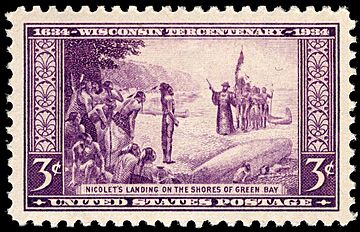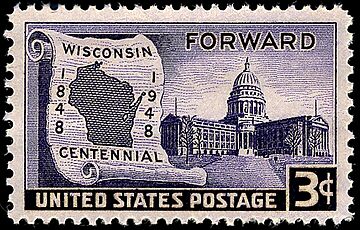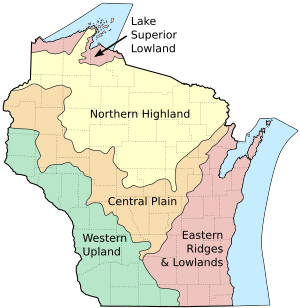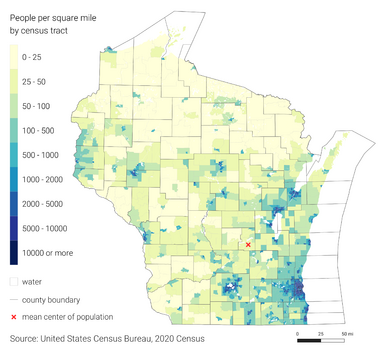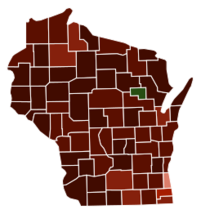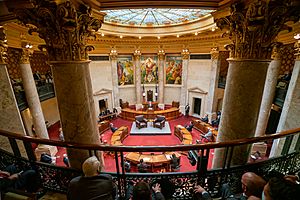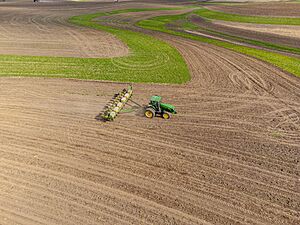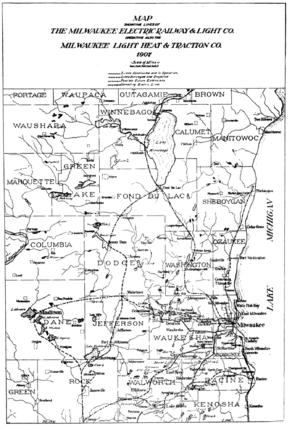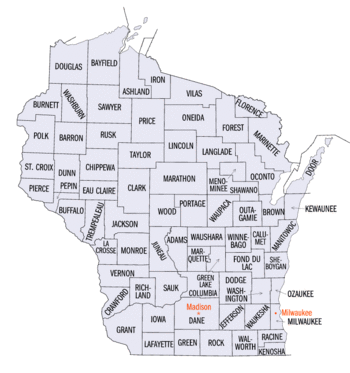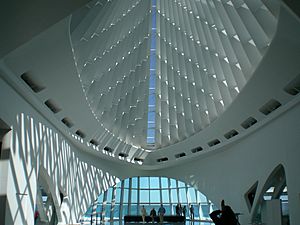Wisconsin facts for kids
Quick facts for kids
Wisconsin
|
|||
|---|---|---|---|
|
|||
| Nicknames:
Badger State, America's Dairyland
|
|||
| Motto(s):
Forward
|
|||
| Anthem: "On, Wisconsin!" | |||
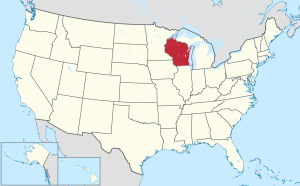
Map of the United States with Wisconsin highlighted
|
|||
| Country | United States | ||
| Before statehood | Wisconsin Territory | ||
| Admitted to the Union | May 29, 1848 (30th) | ||
| Capital | Madison | ||
| Largest city | Milwaukee | ||
| Largest metro | Milwaukee | ||
| Legislature | Wisconsin Legislature | ||
| • Upper house | Senate | ||
| • Lower house | Assembly | ||
| Area | |||
| • Total | 65,498.37 sq mi (169,640.0 km2) | ||
| • Land | 54,153.1 sq mi (140,256 km2) | ||
| Area rank | 23rd | ||
| Dimensions | |||
| • Length | 311 mi (507 km) | ||
| • Width | 260 mi (427 km) | ||
| Elevation | 1,050 ft (320 m) | ||
| Highest elevation | 1,951 ft (595 m) | ||
| Lowest elevation | 579 ft (176 m) | ||
| Population
(2020)
|
|||
| • Total | 5,893,718 | ||
| • Rank | 20th | ||
| • Density | 108.8/sq mi (42.0/km2) | ||
| • Density rank | 27th | ||
| • Median household income | $64,168 | ||
| • Income rank | 21st | ||
| Demonym(s) | Wisconsinite, Cheesehead (colloquial) | ||
| Language | |||
| • Official language | None | ||
| • Spoken language |
|
||
| Time zone | UTC– 06:00 (Central) | ||
| • Summer (DST) | UTC– 05:00 (CDT) | ||
| USPS abbreviation |
WI
|
||
| ISO 3166 code | US-WI | ||
| Trad. abbreviation | Wis., Wisc. | ||
| Latitude | 42° 30' N to 47° 05′ N | ||
| Longitude | 86° 46′ W to 92° 54′ W | ||
Wisconsin ( wiss-KON-sin) is a state in the Upper Midwestern region of the United States. It borders Minnesota to the west, Iowa to the southwest, Illinois to the south, Lake Michigan to the east, Michigan to the northeast, and Lake Superior to the north. Wisconsin is the 25th-largest state by land area and the 20th-most populous.
The bulk of Wisconsin's population live in areas situated along the shores of Lake Michigan. The largest city, Milwaukee, anchors its largest metropolitan area, followed by Green Bay and Kenosha, the third- and fourth-most-populated Wisconsin cities, respectively. The state capital, Madison, is currently the second-most-populated and fastest-growing city in the state. Wisconsin is divided into 72 counties and as of the 2020 census had a population of nearly 5.9 million.
Wisconsin's geography is diverse, having been greatly impacted by glaciers during the Ice Age with the exception of the Driftless Area. The Northern Highland and Western Upland along with a part of the Central Plain occupy the western part of the state, with lowlands stretching to the shore of Lake Michigan. Wisconsin is third to Ontario and Michigan in the length of its Great Lakes coastline. The northern portion of the state is home to the Chequamegon-Nicolet National Forest. At the time of European contact, the area was inhabited by Algonquian and Siouan nations, and today it is home to eleven federally recognized tribes. During the 19th and early 20th centuries, many European settlers entered the state, most of whom emigrated from Germany and Scandinavia. Wisconsin remains a center of German American and Scandinavian American culture, particularly in respect to its cuisine, with foods such as bratwurst and kringle. Wisconsin is home to one UNESCO World Heritage Site, comprising two of the most significant buildings designed by Wisconsin-born architect Frank Lloyd Wright: his studio at Taliesin near Spring Green and his Jacobs I House in Madison.
The Republican Party was founded in Wisconsin in 1854. In more recent years, Wisconsin has been a battleground state in presidential elections, notably in 2016 and 2020.
Wisconsin is one of the nation's leading dairy producers and is known as "America's Dairyland"; it is particularly famous for its cheese. The state is also famous for its beer, particularly and historically in Milwaukee, most notably as the headquarters of the Miller Brewing Company. The state's economy is dominated by manufacturing, healthcare, information technology, and agriculture—specifically dairy, cranberries, and ginseng. Tourism is also a major contributor to the state's economy. The gross domestic product in 2020 was $348 billion.
Contents
Etymology
The word Wisconsin originates from the name given to the Wisconsin River by one of the Algonquian-speaking Native American groups living in the region at the time of European colonization. The French explorer Jacques Marquette was the first European to reach the Wisconsin River, arriving in 1673 and calling the river Meskousing (likely ᒣᔅᑯᐤᓯᣙ meskowsin) in his journal. Subsequent French writers changed the spelling from Meskousing to Ouisconsin, and over time this became the name for both the Wisconsin River and the surrounding lands. English speakers anglicized the spelling from Ouisconsin to Wisconsin when they began to arrive in large numbers during the early 19th century. The legislature of Wisconsin Territory made the current spelling official in 1845.
The Algonquian word for Wisconsin and its original meaning have both grown obscure. While interpretations vary, most implicate the river and the red sandstone that lines its banks. One leading theory holds that the name originated from the Miami word Meskonsing, meaning 'it lies red', a reference to the setting of the Wisconsin River as it flows through the reddish sandstone of the Wisconsin Dells. Other theories include claims that the name originated from one of a variety of Ojibwa words meaning 'red stone place', 'where the waters gather', or 'great rock'.
History
Early history
Wisconsin has been home to a wide variety of cultures over the past 14,000 years. The first people arrived around 10,000 BCE during the Wisconsin Glaciation. These early inhabitants, called Paleo-Indians, hunted now-extinct ice age animals such as the Boaz mastodon, a prehistoric mastodon skeleton unearthed along with spear points in southwest Wisconsin. After the ice age ended around 8000 BCE, people in the subsequent Archaic period lived by hunting, fishing, and gathering food from wild plants. Agricultural societies emerged gradually over the Woodland period between 1000 BCE to 1000 CE. Toward the end of this period, Wisconsin was the heartland of the "Effigy Mound culture", which built thousands of animal-shaped mounds across the landscape. Later, between 1000 and 1500 CE, the Mississippian and Oneota cultures built substantial settlements including the fortified village at Aztalan in southeast Wisconsin. The Oneota may be the ancestors of the modern Ioway and Ho-Chunk nations who shared the Wisconsin region with the Menominee at the time of European contact. Other Native American groups living in Wisconsin when Europeans first settled included the Ojibwa, Sauk, Fox, Kickapoo, and Pottawatomie, who migrated to Wisconsin from the east between 1500 and 1700.
European settlements
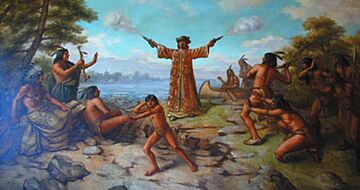
The first European to visit what became Wisconsin was probably the French explorer Jean Nicolet. He canoed west from Georgian Bay through the Great Lakes in 1634, and it is traditionally assumed that he came ashore near Green Bay at Red Banks. Pierre Radisson and Médard des Groseilliers visited Green Bay again in 1654–1666 and Chequamegon Bay in 1659–1660, where they traded for fur with local Native Americans. In 1673, Jacques Marquette and Louis Jolliet became the first to record a journey on the Fox-Wisconsin Waterway all the way to the Mississippi River near Prairie du Chien. Frenchmen like Nicholas Perrot continued to ply the fur trade across Wisconsin through the 17th and 18th centuries, but the French made no permanent settlements in Wisconsin before Great Britain won control of the region following the French and Indian War in 1763. Even so, French traders continued to work in the region after the war, and some, beginning with Charles de Langlade in 1764, settled in Wisconsin permanently, rather than returning to British-controlled Canada.
The British gradually took over Wisconsin during the French and Indian War, taking control of Green Bay in 1761 and gaining control of all of Wisconsin in 1763. Like the French, the British were interested in little but the fur trade. One notable event in the fur trading industry in Wisconsin occurred in 1791, when two free African Americans set up a fur trading post among the Menominee at present-day Marinette. The first permanent settlers, mostly French Canadians, some Anglo-New Englanders and a few African American freedmen, arrived in Wisconsin while it was under British control. Charles de Langlade is generally recognized as the first settler, establishing a trading post at Green Bay in 1745, and moving there permanently in 1764. Settlement began at Prairie du Chien around 1781. The French residents at the trading post in what is now Green Bay, referred to the town as "La Baye". However, British fur traders referred to it as "Green Bay", because the water and the shore assumed green tints in early spring. The old French title was gradually dropped, and the British name of "Green Bay" eventually stuck. The region coming under British rule had virtually no adverse effect on the French residents as the British needed the cooperation of the French fur traders and the French fur traders needed the goodwill of the British. During the French occupation of the region licenses for fur trading had been issued scarcely and only to select groups of traders, whereas the British, in an effort to make as much money as possible from the region, issued licenses for fur trading freely, both to British and to French residents. The fur trade in what is now Wisconsin reached its height under British rule, and the first self-sustaining farms in the state were established as well. From 1763 to 1780, Green Bay was a prosperous community which produced its own foodstuff, built graceful cottages and held dances and festivities.
Joseph Roi built the Tank Cottage in Green Bay in 1776. Located in Heritage Hill State Historical Park, it is the oldest standing building from Wisconsin's early years and is listed on the National Register of Historic Places.
U.S. territory
Wisconsin became a territorial possession of the United States in 1783 after the American Revolutionary War. In 1787, it became part of the Northwest Territory. As territorial boundaries subsequently developed, it was then part of Indiana Territory from 1800 to 1809, Illinois Territory from 1809 to 1818, and Michigan Territory from 1818 to 1836. However, the British remained in control until after the War of 1812, the outcome of which finally established an American presence in the area. Under American control, the economy of the territory shifted from fur trading to lead mining. The prospect of easy mineral wealth drew immigrants from throughout the U.S. and Europe to the lead deposits located at Mineral Point, Dodgeville, and nearby areas. Some miners found shelter in the holes they had dug, and earned the nickname "badgers", leading to Wisconsin's identity as the "Badger State". The sudden influx of white miners prompted tension with the local Native American population. The Winnebago War of 1827 and the Black Hawk War of 1832 culminated in the forced removal of Native Americans from most parts of the state.
Following these conflicts, Wisconsin Territory was created by an act of the United States Congress on April 20, 1836. By fall of that year, the best prairie groves of the counties surrounding what is now Milwaukee were occupied by farmers from the New England states.
Statehood
The Erie Canal facilitated the travel of both Yankee settlers and European immigrants to Wisconsin Territory. Yankees from New England and upstate New York seized a dominant position in law and politics, enacting policies that marginalized the region's earlier Native American and French-Canadian residents. Yankees also speculated in real estate, platted towns such as Racine, Beloit, Burlington, and Janesville, and established schools, civic institutions, and Congregationalist churches. At the same time, many Germans, Irish, Norwegians, and other immigrants also settled in towns and farms across the territory, establishing Catholic and Lutheran institutions.
The growing population allowed Wisconsin to gain statehood on May 29, 1848, as the 30th state. Between 1840 and 1850, Wisconsin's non-Indian population had swollen from 31,000 to 305,000. More than a third of residents (110,500) were foreign born, including 38,000 Germans, 28,000 British immigrants from England, Scotland, and Wales, and 21,000 Irish. Another third (103,000) were Yankees from New England and western New York state. Only about 63,000 residents in 1850 had been born in Wisconsin.
Nelson Dewey, the first governor of Wisconsin, was a Democrat. Dewey oversaw the transition from the territorial to the new state government. He encouraged the development of the state's infrastructure, particularly the construction of new roads, railroads, canals, and harbors, as well as the improvement of the Fox and Wisconsin Rivers. During his administration, the State Board of Public Works was organized. Dewey, an abolitionist, was the first of many Wisconsin governors to advocate against the spread of slavery into new states and territories.
Civil War
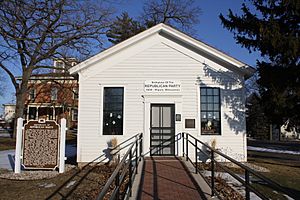
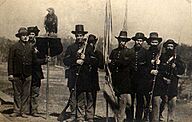
Politics in early Wisconsin were defined by the greater national debate over slavery. A free state from its foundation, Wisconsin became a center of northern abolitionism. The debate became especially intense in 1854 after Joshua Glover, a runaway slave from Missouri, was captured in Racine. Glover was taken into custody under the Federal Fugitive Slave Law, but a mob of abolitionists stormed the prison where Glover was held and helped him escape to Canada. In a trial stemming from the incident, the Wisconsin Supreme Court ultimately declared the Fugitive Slave Law unconstitutional. The Republican Party, founded on March 20, 1854, by anti-slavery expansion activists in Ripon, Wisconsin, grew to dominate state politics in the aftermath of these events. During the Civil War, around 91,000 troops from Wisconsin fought for the Union.
Economic progress

Wisconsin's economy also diversified during the early years of statehood. While lead mining diminished, agriculture became a principal occupation in the southern half of the state. Railroads were built across the state to help transport grains to market, and industries like J.I. Case & Company in Racine were founded to build agricultural equipment. Wisconsin briefly became one of the nation's leading producers of wheat during the 1860s. Meanwhile, the lumber industry dominated in the heavily forested northern sections of Wisconsin, and sawmills sprang up in cities like La Crosse, Eau Claire, and Wausau. These economic activities had dire environmental consequences. By the close of the 19th century, intensive agriculture had devastated soil fertility, and lumbering had deforested most of the state. These conditions forced both wheat agriculture and the lumber industry into a precipitous decline.
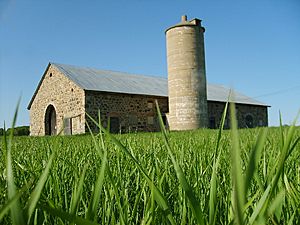
Beginning in the 1890s, farmers in Wisconsin shifted from wheat to dairy production to make more sustainable and profitable use of their land. Many immigrants carried cheese-making traditions that, combined with the state's suitable geography and dairy research led by Stephen Babcock at the University of Wisconsin, helped the state build a reputation as "America's Dairyland". Meanwhile, conservationists including Aldo Leopold helped re-establish the state's forests during the early 20th century, paving the way for a more renewable lumber and paper milling industry as well as promoting recreational tourism in the northern woodlands. Manufacturing also boomed in Wisconsin during the early 20th century, driven by an immense immigrant workforce arriving from Europe. Industries in cities like Milwaukee ranged from brewing and food processing to heavy machine production and tool-making, leading Wisconsin to rank 8th among U.S. states in total product value by 1910.
20th century

The early 20th century was also notable for the emergence of progressive politics championed by Robert M. La Follette. Between 1901 and 1914, Progressive Republicans in Wisconsin created the nation's first comprehensive statewide primary election system, the first effective workplace injury compensation law, and the first state income tax, making taxation proportional to actual earnings. The progressive Wisconsin Idea also promoted the statewide expansion of the University of Wisconsin through the UW-Extension system at this time. Later, UW economics professors John R. Commons and Harold Groves helped Wisconsin create the first unemployment compensation program in the United States in 1932.
World War I
During World War I, due to the neutrality of Wisconsin and many Wisconsin Republicans, progressives, and German immigrants which made up 30 to 40 percent of the state population, Wisconsin would gain the nickname "Traitor State" which was used by many "hyper patriots".
As the war raged on in Europe, Robert M. La Follette, leader of the anti-war movement in Wisconsin. led a group of progressive senators in blocking a bill by president Woodrow Wilson which would have armed merchant ships with guns. Many Wisconsin politicians such as Governor Phillipp and senator Irvine Lernroot were accused of having divided loyalties. Even with outspoken opponents to the war, at the onset of the war many Wisconsinites would abandon neutrality. Businesses, labor and farms all enjoyed prosperity from the war. With over 118,000 going into military service, Wisconsin was the first state to report for the national drafts conducted by the U.S. military.
Cold war

In the immediate aftermath of World War II, citizens of Wisconsin were divided over issues such as creation of the United Nations, support for the European recovery, and the growth of the Soviet Union's power. However, when Europe divided into Communist and capitalist camps and the Communist revolution in China succeeded in 1949, public opinion began to move towards support for the protection of democracy and capitalism against Communist expansion.
Wisconsin took part in several political extremes in the mid to late 20th century, ranging from the anti-communist crusades of Senator Joseph McCarthy in the 1950s to the radical antiwar protests at UW-Madison that culminated in the Sterling Hall bombing in August 1970. The state undertook welfare reform under Republican Governor Tommy Thompson during the 1990s. The state's economy also underwent further transformations towards the close of the 20th century, as heavy industry and manufacturing declined in favor of a service economy based on medicine, education, agribusiness, and tourism.
Two U.S. Navy battleships, BB-9 and BB-64, were named for the state.
21st century
Wisconsin has been a swing state for much of the 21st century, with both Republicans and Democrats being elected statewide. The state voted for Donald Trump in the 2016 Presidential Election, and Joe Biden in 2020.
Geography
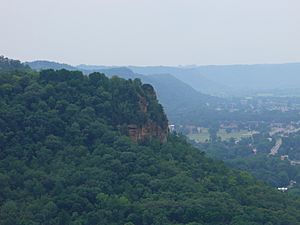
The Driftless Area of southwestern Wisconsin is characterized by bluffs carved in sedimentary rock by water from melting Ice age glaciers.
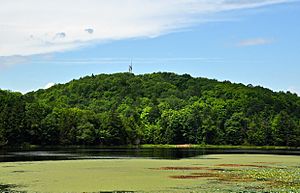
Timms Hill is the highest natural point in Wisconsin at 1,951.5 ft (594.8 m); it is located in the Town of Hill, Price County.
|
Wisconsin is bordered by the Montreal River; Lake Superior and Michigan to the north; by Lake Michigan to the east; by Illinois to the south; and by Iowa to the southwest and Minnesota to the northwest. A border dispute with Michigan was settled by two cases, both Wisconsin v. Michigan, in 1934 and 1935. The state's boundaries include the Mississippi River and St. Croix River in the west, and the Menominee River in the northeast.
With its location between the Great Lakes and the Mississippi River, Wisconsin is home to a wide variety of geographical features. The state is divided into five distinct regions. In the north, the Lake Superior Lowland occupies a belt of land along Lake Superior. Just to the south, the Northern Highland has massive mixed hardwood and coniferous forests including the 1,500,000-acre (610,000-hectare) Chequamegon-Nicolet National Forest, as well as thousands of glacial lakes, and the state's highest point, Timms Hill. In the middle of the state, the Central Plain has some unique sandstone formations like the Dells of the Wisconsin River in addition to rich farmland. The Eastern Ridges and Lowlands region in the southeast is home to many of Wisconsin's largest cities. The ridges include the Niagara Escarpment that stretches from New York, the Black River Escarpment and the Magnesian Escarpment.
In the southwest, the Western Upland is a rugged landscape with a mix of forest and farmland, including many bluffs on the Mississippi River. This region is part of the Driftless Area, which also includes portions of Iowa, Illinois, and Minnesota. This area was not covered by glaciers during the most recent ice age, the Wisconsin Glaciation. Overall, 46% of Wisconsin's land area is covered by forest. Langlade County has a soil rarely found outside the county called Antigo silt loam.
Wisconsin has sister-state relationships with Germany's Hesse, Japan's Chiba Prefecture, Mexico's Jalisco, China's Heilongjiang, and Nicaragua.
Climate
Most of Wisconsin is classified as warm-summer humid continental climate (Köppen Dfb), while southern and southwestern portions are classified as hot-summer humid continental climate (Köppen Dfa). The highest temperature ever recorded in the state was in the Wisconsin Dells, on July 13, 1936, where it reached 114 °F (46 °C). The lowest temperature ever recorded in Wisconsin was in the village of Couderay, where it reached −55 °F (−48 °C) on both February 2 and 4, 1996. Wisconsin also receives a large amount of regular snowfall averaging around 40 inches (100 cm) in the southern portions with up to 160 inches (410 cm) annually in the Lake Superior snowbelt each year.
| City | Jan | Feb | Mar | Apr | May | Jun | Jul | Aug | Sep | Oct | Nov | Dec |
|---|---|---|---|---|---|---|---|---|---|---|---|---|
| Green Bay | 25/10 (−4/−12) |
29/13 (−2/−11) |
40/23 (5/−5) |
55/35 (13/1) |
67/45 (19/7) |
76/55 (25/13) |
81/59 (27/15) |
79/58 (26/14) |
71/49 (22/10) |
58/38 (14/4) |
43/28 (6/−2) |
30/15 (−1/−9) |
| Hurley | 19/0 (−7/−18) |
26/4 (−4/−16) |
36/16 (2/−9) |
49/29 (9/−2) |
65/41 (18/5) |
73/50 (23/10) |
76/56 (25/13) |
75/54 (24/12) |
65/46 (18/8) |
53/35 (12/2) |
36/22 (2/−6) |
24/8 (−5/−14) |
| La Crosse | 26/6 (−3/−14) |
32/13 (0/−11) |
45/24 (7/−4) |
60/37 (16/3) |
72/49 (22/9) |
81/58 (27/14) |
85/63 (29/17) |
82/61 (28/16) |
74/52 (23/11) |
61/40 (16/4) |
44/27 (7/−3) |
30/14 (−1/−10) |
| Madison | 27/11 (−3/−12) |
32/15 (0/−9) |
44/25 (7/−4) |
58/36 (14/2) |
69/46 (21/8) |
79/56 (26/13) |
82/61 (28/16) |
80/59 (27/15) |
73/50 (23/10) |
60/39 (15/3) |
45/28 (7/−2) |
31/16 (−1/−9) |
| Milwaukee | 29/16 (−2/−9) |
33/19 (0/−7) |
42/28 (6/−2) |
54/37 (12/3) |
65/47 (18/8) |
75/57 (24/14) |
80/64 (27/18) |
79/63 (26/17) |
71/55 (22/13) |
59/43 (15/6) |
46/32 (8/0) |
33/20 (0/−7) |
| Superior | 21/2 (−6/−17) |
26/6 (−3/−14) |
35/17 (2/−8) |
46/29 (8/-2) |
56/38 (13/3) |
66/47 (19/8) |
75/56 (24/13) |
74/57 (23/14) |
65/47 (18/8) |
52/36 (11/2) |
38/23 (3/−5) |
25/9 (−4/−13) |
Demographics
Population
| Historical population | |||
|---|---|---|---|
| Census | Pop. | %± | |
| 1820 | 1,444 | — | |
| 1830 | 3,635 | 151.7% | |
| 1840 | 30,945 | 751.3% | |
| 1850 | 305,391 | 886.9% | |
| 1860 | 775,881 | 154.1% | |
| 1870 | 1,054,670 | 35.9% | |
| 1880 | 1,315,457 | 24.7% | |
| 1890 | 1,693,330 | 28.7% | |
| 1900 | 2,069,042 | 22.2% | |
| 1910 | 2,333,860 | 12.8% | |
| 1920 | 2,632,067 | 12.8% | |
| 1930 | 2,939,006 | 11.7% | |
| 1940 | 3,137,587 | 6.8% | |
| 1950 | 3,434,575 | 9.5% | |
| 1960 | 3,951,777 | 15.1% | |
| 1970 | 4,417,731 | 11.8% | |
| 1980 | 4,705,767 | 6.5% | |
| 1990 | 4,891,769 | 4.0% | |
| 2000 | 5,363,675 | 9.6% | |
| 2010 | 5,686,986 | 6.0% | |
| 2020 | 5,893,718 | 3.6% | |
| Source: 1910–2020 | |||
The United States Census Bureau estimates that the population of Wisconsin was 5,822,434 on July 1, 2019, a 2.4% increase since the 2010 United States census. This includes a natural increase since the last census of 150,659 people (i.e., 614,771 births minus 464,112 deaths) and a decrease due to net migration of 12,755 people. Immigration resulted in a net increase of 59,251 people, and migration from within the U.S. resulted in a net decrease of 72,006 people.
According to HUD's 2022 Annual Homeless Assessment Report, there were an estimated 4,775 homeless people in Wisconsin.
| Race and Ethnicity | Alone | Total | ||
|---|---|---|---|---|
| White (non-Hispanic) | 78.6% |
|
81.9% |
|
| Hispanic or Latino | — | 7.6% |
|
|
| African American (non-Hispanic) | 6.2% |
|
7.3% |
|
| Asian | 3.0% |
|
3.6% |
|
| Native American | 0.8% |
|
2.0% |
|
| Pacific Islander | 0.03% |
|
0.1% |
|
| Other | 0.3% |
|
1.1% |
|
| Racial composition | 1990 | 2000 | 2010 | 2020 |
|---|---|---|---|---|
| White | 92.2% | 88.9% | 86.2% | 80.4% |
| Black | 5.0% | 5.7% | 6.3% | 6.4% |
| Asian | 1.1% | 1.7% | 2.3% | 3.0% |
| Native | 0.8% | 0.9% | 1.0% | 1.0% |
| Native Hawaiian and other Pacific Islander |
– | – | – | – |
| Other race | 0.9% | 1.6% | 2.4% | 3.1% |
| Two or more races | – | 1.3% | 1.8% | 6.1% |
According to the 2016 American Community Survey, 6.5% of Wisconsin's population were of Hispanic or Latino origin (of any race): Mexican (4.7%), Puerto Rican (0.9%), Cuban (0.1%), and other Hispanic or Latino origin (0.7%). The five largest ancestry groups were: German (40.5%), Irish (10.8%), Polish (8.8%), Norwegian (7.7%), and English (5.7%). German is the most common ancestry in every county in the state, except Menominee, Trempealeau, and Vernon. Wisconsin has the highest percentage of residents of Polish ancestry of any state.
Since its founding, Wisconsin has been ethnically heterogeneous. Following the period of French fur traders, the next wave of settlers were miners, many of whom were Cornish, who settled the southwestern area of the state. The next wave was dominated by "Yankees", migrants of English descent from New England and upstate New York; in the early years of statehood, they dominated the state's heavy industry, finance, politics, and education. Between 1850 and 1900, the immigrants were mostly Germans, Scandinavians (the largest group being Norwegian), Irish, and Poles. In the 20th century, a number of African Americans and Mexicans settled in Milwaukee; and after the end of the Vietnam War came an influx of Hmongs.
The various ethnic groups settled in different areas of the state. Although German immigrants settled throughout the state, the largest concentration was in Milwaukee. Norwegian immigrants settled in lumbering and farming areas in the north and west. Irish, Italian, and Polish immigrants settled primarily in urban areas. Menominee County is the only county in the eastern United States with a Native American majority.
African Americans came to Milwaukee, especially from 1940 on. 86% of Wisconsin's African-American population live in four cities: Milwaukee, Racine, Beloit, Kenosha, with Milwaukee home to nearly three-fourths of the state's black Americans. In the Great Lakes region, only Detroit and Cleveland have a higher percentage of African-American residents.
About 33% of Wisconsin's Asian population is Hmong, with significant communities in Milwaukee, Wausau, Green Bay, Sheboygan, Appleton, Madison, La Crosse, Eau Claire, Oshkosh, and Manitowoc.
Of the residents of Wisconsin, 71.7% were born in Wisconsin, 23.0% were born in a different US state, 0.7% were born in Puerto Rico, U.S. Island areas, or born abroad to American parent(s), and 4.6% were foreign born.
In 2018, the countries of origin for Wisconsin's immigrants came from Mexico, India, China, Laos and the Philippines.
- Birth data
Note: Births in table add to over 100%, because Hispanics are counted both by their ethnicity and by their race, giving a higher overall number.
| Race | 2013 | 2014 | 2015 | 2016 | 2017 | 2018 | 2019 | 2020 | 2021 | 2022 |
|---|---|---|---|---|---|---|---|---|---|---|
| White: | 55,485 (83.2%) | 55,520 (82.7%) | 55,350 (82.6%) | ... | ... | ... | ... | ... | ... | ... |
| > Non-Hispanic White | 49,357 (74.0%) | 49,440 (73.6%) | 49,024 (73.1%) | 47,994 (72.0%) | 46,309 (71.3%) | 45,654 (71.2%) | 44,784 (70.8%) | 42,715 (70.5%) | 43,991 (71.2%) | 42,455 (70.7%) |
| Black | 6,956 (10.4%) | 7,328 (10.9%) | 7,386 (11.0%) | 6,569 (9.9%) | 6,864 (10.6%) | 6,622 (10.3%) | 6,859 (10.8%) | 6,429 (10.6%) | 5,964 (9.6%) | 5,688 (9.5%) |
| Asian | 3,197 (4.8%) | 3,333 (5.0%) | 3,276 (4.9%) | 3,220 (4.8%) | 3,017 (4.6%) | 3,155 (4.9%) | 2,942 (4.6%) | 2,870 (4.7%) | 2,692 (4.3%) | 2,661 (4.4%) |
| American Indian | 1,011 (1.5%) | 980 (1.5%) | 1,029 (1.5%) | 689 (1.0%) | 745 (1.1%) | 707 (1.1%) | 664 (1.0%) | 573 (0.9%) | 546 (0.9%) | 533 (0.9%) |
| Hispanic (of any race) | 6,398 (9.6%) | 6,375 (9.5%) | 6,604 (9.9%) | 6,504 (9.8%) | 6,368 (9.8%) | 6,365 (9.9%) | 6,463 (10.2%) | 6,438 (10.6%) | 6,923 (11.2%) | 6,971 (11.6%) |
| Total Wisconsin | 66,649 (100%) | 67,161 (100%) | 67,041 (100%) | 66,615 (100%) | 64,975 (100%) | 64,098 (100%) | 63,270 (100%) | 60,594 (100%) | 61,781 (100%) | 60,049 (100%) |
- Since 2016, data for births of White Hispanic origin are not collected, but included in one Hispanic group; persons of Hispanic origin may be of any race.
Religion
| Religion in Wisconsin (2014) | ||||
|---|---|---|---|---|
| religion | percent | |||
| Protestant | 44% | |||
| Catholic | 25% | |||
| Unaffiliated | 25% | |||
| Jewish | 1% | |||
| Eastern Orthodox | 1% | |||
| Jehovah's Witness | 1% | |||
| Islam | 1% | |||
| Other faith | 1% | |||
The percentage of Wisconsin residents who belong to various affiliations as of 2014 were: Christian 81% (Protestant 50%, Roman Catholic 29%), Mormon 0.5%, Jewish 0.5%, Muslim 0.5%, Buddhist 0.5%, Hindu 0.5%, and unaffiliated 15%.
Christianity is the predominant religion of Wisconsin. As of 2008, the three largest denominational groups in Wisconsin were Catholic, Evangelical Protestant, and Mainline Protestant. As of 2010, the Catholic Church had the highest number of adherents in Wisconsin (at 1,425,523), followed by the Evangelical Lutheran Church in America with 414,326 members, and the Lutheran Church–Missouri Synod with 223,279 adherents. The Wisconsin Evangelical Lutheran Synod, the namesake synod with the fourth highest numbers of adherents in Wisconsin, has their headquarters in Waukesha, Wisconsin.
Government
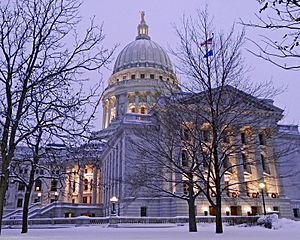
Wisconsin's Constitution outlines the structure and function of state government, which is organized into three branches: executive, legislative, and judicial. The Wisconsin Blue Book is the primary published reference about the government and politics of the state. Re-published every two years, copies are available from state legislators.
In a 2020 study, Wisconsin was ranked as the 25th easiest state for citizens to vote in.
Executive
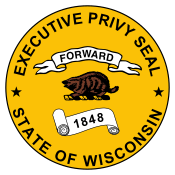
The executive branch is headed by the governor. The current governor, Tony Evers, assumed office on January 7, 2019. In addition to the governor, the executive branch includes five other elected constitutional officers: Lieutenant Governor, Secretary of State, Attorney General, Treasurer, and State Superintendent of Public Instruction. Four members of the Wisconsin executive branch are Democrats. The Superintendent of Public Instruction of Wisconsin is a non-partisan position.
Legislative
The Wisconsin State Legislature is Wisconsin's legislative branch. The Legislature is a bicameral body consisting of the Assembly and the Senate.
Judicial
Wisconsin's court system has four levels: municipal courts, circuit courts, the Court of Appeals, and the Supreme Court. Municipal courts typically handle cases involving local ordinance matters. The circuit courts are Wisconsin's trial courts, they have original jurisdiction in all civil and criminal cases within the state. Challenges to circuit court rulings are heard by the Wisconsin Court of Appeals, consisting of sixteen judges who typically sit in three-judge panels. As the state's highest appellate court, the Wisconsin Supreme Court may hear both appeals from lower courts and original actions. In addition to deciding cases, the Supreme Court is responsible for administering the state's court system and regulating the practice of law in Wisconsin.
Agencies
- Department of Administration
- Department of Agriculture, Trade and Consumer Protection
- Department of Children and Families
- Wisconsin Department of Corrections
- Employee Trust Fund
- Wisconsin Department of Financial Institutions
- Wisconsin Department of Health Services
- Wisconsin Historical Society
- Wisconsin Department of Justice
- Wisconsin Department of Military Affairs
- Wisconsin Department of Natural Resources
- Office of the State Public Defender
- Wisconsin Department of Tourism
- Department of Safety and Professional Services
- Wisconsin Department of Public Instruction
- Public Service Commission of Wisconsin
- Wisconsin Department of Revenue
- Wisconsin Department of Transportation
- Wisconsin Department of Veterans Affairs
- Wisconsin Department of Workforce Development
- Wisconsin Educational Communications Board
- Office of the Commissioner of Insurance
- Board on Aging and Long Term care
- Wisconsin Technical College System
Economy
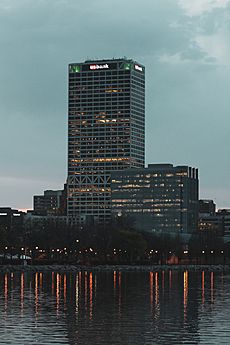
In 2019 Wisconsin's gross state product was $349.416 billion, making it 21st among U.S. states. The economy of Wisconsin is driven by manufacturing, agriculture, and health care. The state's economic output from manufacturing was $48.9 billion in 2008, making it the tenth largest among states in manufacturing gross domestic product. Manufacturing accounts for about 20% of the state's gross domestic product, a proportion that is third among all states. The per capita personal income was $35,239 in 2008. In March 2017, the state's unemployment rate was 3.4% (seasonally adjusted). Since 2009, Wisconsin's minimum wage has been $7.25, the same as the federal rate.
In quarter four of 2011, the largest employers in Wisconsin were:
- Walmart
- University of Wisconsin–Madison
- Milwaukee Public Schools
- U.S. Postal Service
- Wisconsin Department of Corrections
- Menards
- Marshfield Clinic
- Wisconsin Department of Veterans Affairs
- Target Corporation, and
- City of Milwaukee.
Agriculture
Wisconsin produces about a quarter of America's cheese, leading the nation in cheese production. It is second in milk production, after California, and third in per-capita milk production, behind California and Vermont. Wisconsin is second in butter production, producing about one-quarter of the nation's butter. The state ranks first nationally in the production of corn for silage, cranberries, ginseng, and snap beans for processing. It grows more than half the national crop of cranberries. and 97% of the nation's ginseng. Wisconsin is also a leading producer of oats, potatoes, carrots, tart cherries, maple syrup, and sweet corn for processing. The significance of the state's agricultural production is exemplified by the depiction of a Holstein cow, an ear of corn, and a wheel of cheese on Wisconsin's state quarter design. The state annually selects an "Alice in Dairyland" to promote the state's agricultural products around the world.
A large part of the state's manufacturing sector includes commercial food processing, including well-known brands such as Oscar Mayer, Tombstone frozen pizza, Johnsonville brats, and Usinger's sausage. Kraft Foods alone employs more than 5,000 people in the state. Milwaukee is a major producer of beer and was formerly headquarters for Miller Brewing Company—the nation's second-largest brewer—until it merged with Coors. Formerly, Schlitz, Blatz, and Pabst were cornerstone breweries in Milwaukee.
| Badger State | |
| State animal: | Badger |
| State Domesticated Animal: |
Dairy cow |
| State Wild Animal: | White-tailed deer |
| State beverage: | Milk |
| State Dairy Product: | Cheese |
| State Fruit: | Cranberry |
| State Bird: | Robin |
| State Capital: | Madison |
| State Dog: | American water spaniel |
| State pro football team: | Green Bay Packers |
| State pro baseball team: | Milwaukee Brewers |
| State pro basketball team: | Milwaukee Bucks |
| State pro hockey team: | Milwaukee Admirals |
| State Fish: | Muskellunge |
| State Flower: | Wood violet |
| State Fossil: | Trilobite |
| State Grain: | Corn |
| State Insect: | European honey bee |
| State Motto: | Forward |
| State Song: | "On, Wisconsin!" |
| State Tree: | Sugar maple |
| State Mineral: | Galena (Lead sulfide) |
| State Rock: | Red granite |
| State Soil: | Antigo silt loam |
| State Dance: | Polka |
| State Symbol of Peace: |
Mourning dove |
| State microbe | Lactococcus lactis |
| State Pastry: | Kringle |
Manufacturing
Wisconsin is home to a very large and diversified manufacturing economy, with special focus on transportation and capital equipment. Major Wisconsin companies in these categories include the Kohler Company; Mercury Marine; Rockwell Automation; Johnson Controls; John Deere; Briggs & Stratton; Milwaukee Electric Tool Company; Miller Electric; Caterpillar Inc.; Joy Global; Oshkosh Corporation; Harley-Davidson; Case IH; S. C. Johnson & Son; Ashley Furniture; Ariens; and Evinrude Outboard Motors.
Consumer goods
Wisconsin is a major producer of paper, packaging, and other consumer goods. Major consumer products companies based in the state include SC Johnson & Co., and Diversey, Inc. Wisconsin also ranks first nationwide in the production of paper products; the lower Fox River from Lake Winnebago to Green Bay has 24 paper mills along its 39 miles (63 km) stretch.
The development and manufacture of health care devices and software is a growing sector of the state's economy, with key players such as GE Healthcare, Epic Systems, and TomoTherapy.
Tourism
Tourism is a major industry in Wisconsin—the state's third largest, according to the Department of Tourism. Tourist destinations such as the House on the Rock near Spring Green, Circus World Museum in Baraboo, and The Dells of the Wisconsin River draw thousands of visitors annually, and festivals such as Summerfest and the EAA Oshkosh Airshow draw international attention, along with hundreds of thousands of visitors.
Given the large number of lakes and rivers in the state, water recreation is very popular. In the North Country, what had been an industrial area focused on timber has largely been transformed into a vacation destination. Popular interest in the environment and environmentalism, added to traditional interests in hunting and fishing, has attracted a large urban audience within driving range.
The distinctive Door Peninsula, which extends off the eastern coast of the state, contains one of the state's tourist destinations, Door County. Door County is a popular destination for boaters because of the large number of natural harbors, bays, and boat launches on both the Green Bay and Lake Michigan sides of the peninsula that forms the county. The area draws more than two million visitors yearly to its quaint villages, seasonal cherry picking, and fish boils.
Film industry
On January 1, 2008, a new tax incentive for the film industry came into effect. The first major production to take advantage was Michael Mann's Public Enemies. While the producers spent $18 million on the film, it was reported that most of it went to out-of-state workers and for out-of-state services; Wisconsin taxpayers had provided $4.6 million in subsidies, and derived only $5 million in revenues from the film's making. During this period, the movie Transformers: Dark of the Moon also used Milwaukee as a filming location. This incentive was eliminated in 2013.
Energy
Wisconsin has no production of oil, gas, or coal. Its in-state electrical generation is mostly from coal. Other important electricity sources are natural gas and nuclear.
The state has a mandate that ten percent of its electrical energy come from renewable sources by the end of 2015. This goal has been met, but not with in-state sources. As of 2014[update], a third of that ten percent comes from out-of-state sources, mostly wind-generated electricity from Minnesota and Iowa. The state has agnostic policies for developing wind power in state.
Transportation
Airports
Wisconsin is served by eight commercial service airports, in addition to a number of general aviation airports. Milwaukee Mitchell International Airport is the largest international commercial airport located in Wisconsin.
Intercity bus service
Wisconsin is served by multiple intercity bus operators, which provide service to 71 stops and 53 cities. The following carriers provide scheduled bus service: Amtrak Thruway, Badger Bus, Flixbus, Greyhound Lines, Indian Trails, Jefferson Lines, Lamers Bus Lines, Megabus, Van Galder Bus Company, and Wisconsin Coach Lines.
Major highways
The Wisconsin Department of Transportation is responsible for planning, building and maintaining the state's highways. Eight Interstate Highways are located in the state.
Rail service
Amtrak provides daily passenger rail service between Chicago and Milwaukee through the Hiawatha Service. Also provided is cross-country service via the Empire Builder with stops in several cities across Wisconsin. Commuter rail provider Metra's Union Pacific North (UP-N) line has its northern terminus in Kenosha, the only Metra line and station in the state of Wisconsin. The Hop, a modern streetcar system in Milwaukee, began service in 2018. The 2.1 mile (3.4 km) initial line runs from Milwaukee Intermodal Station to Burns Commons. The system is expected to be expanded in the future.
Important municipalities
Over 68% of Wisconsin residents live in urban areas, with the Greater Milwaukee area home to roughly one-third of the state's population. With more than 590,000 residents, Milwaukee is the 30th-largest city in the country. The string of cities along the western edge of Lake Michigan is generally considered to be an example of a megalopolis.
With a population of nearly 260,000, Madison is consistently ranked as one of the most livable cities in both the state and country and is the fastest-growing city in Wisconsin.
Medium-size cities dot the state and anchor a network of working farms surrounding them. As of 2011, there were 12 cities in Wisconsin with a population of 50,000 or more, accounting for 73% of the state's employment.
Wisconsin has three types of municipality: cities, villages, and towns. Cities and villages are incorporated urban areas. Towns are unincorporated minor civil divisions of counties with limited self-government.
|
Largest cities or towns in Wisconsin
|
||
|---|---|---|
| Rank | Name | Pop. |
| 1 | Milwaukee | 577,222 |
| 2 | Madison | 269,840 |
| 3 | Green Bay | 107,395 |
| 4 | Kenosha | 99,986 |
| 5 | Racine | 77,816 |
| 6 | Appleton | 75,644 |
| 7 | Waukesha | 71,158 |
| 8 | Eau Claire | 69,421 |
| 9 | Oshkosh | 66,816 |
| 10 | Janesville | 65,615 |
Education
Wisconsin, along with Minnesota and Michigan, was among the Midwestern leaders in the emergent American state university movement following the Civil War in the United States. By the start of the 20th century, education in the state advocated the "Wisconsin Idea", which emphasized service to the people of the state. The "Wisconsin Idea" exemplified the Progressive movement within colleges and universities at the time.
Today, public post-secondary education in Wisconsin includes both the 26-campus University of Wisconsin System, with the flagship university University of Wisconsin–Madison, and the 16-campus Wisconsin Technical College System. Private colleges and universities include Alverno College, Beloit College, Cardinal Stritch University, Carroll University, Carthage College, Concordia University Wisconsin, Edgewood College, Lakeland College, Lawrence University, Marquette University, Medical College of Wisconsin, Milwaukee School of Engineering, Ripon College, St. Norbert College, Wisconsin Lutheran College, Viterbo University, and others.
Culture
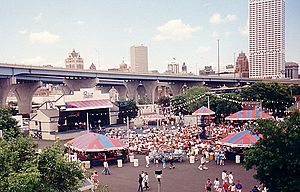

Residents of Wisconsin are referred to as Wisconsinites. The traditional prominence of references to dairy farming and cheesemaking in Wisconsin's rural economy (the state's license plates have read "America's Dairyland" since 1940) have led to the nickname (sometimes used pejoratively among non-residents) of "cheeseheads", and to the creation of "cheesehead hats" made of yellow foam in the shape of a wedge of cheese.
Numerous ethnic festivals are held throughout Wisconsin to celebrate the heritage of its citizens. Such festivals include Summerfest, Oktoberfest, Polish Fest, Festa Italiana, Irish Fest, Bastille Days, Syttende Mai (Norwegian Constitution Day), Brat(wurst) Days in Sheboygan, Polka Days, Cheese Days in Monroe and Mequon, African World Festival, Indian Summer, Arab Fest, Wisconsin Highland Games, and many others.
Art
Music
Wisconsin's music festivals include Eaux Claires, Country Fest, Country Jam USA, the Hodag Country Festival, Porterfield Country Music Festival, Country Thunder USA in Twin Lakes, and Country USA. Milwaukee hosts Summerfest, dubbed "The World's Largest Music Festival", every year. This festival is held at the lakefront Henry Maier Festival Park just south of downtown, as are a summer-long array of ethnic musical festivals. The Wisconsin Area Music Industry provides an annual WAMI event where it presents an awards show for top Wisconsin artists.
Architecture
The Milwaukee Art Museum, with its brise soleil designed by Santiago Calatrava, is known for its interesting architecture. Monona Terrace in Madison, a convention center designed by Taliesin architect Anthony Puttnam, is based on a 1930s design by Wisconsin native Frank Lloyd Wright. Wright's home and studio in the 20th century was at Taliesin, south of Spring Green. Decades after Wright's death, Taliesin remains an architectural office and school for his followers.
With the immigration of northern Europeans into Wisconsin and the upper Midwest, they brought the techniques of building Log homes with them.
Recreation
The varied landscape of Wisconsin makes the state a popular vacation destination for outdoor recreation. Winter events include skiing, ice fishing and snowmobile derbies. Wisconsin is situated on two Great Lakes and has many inland lakes of varied size; the state contains 11,188 square miles (28,980 km2) of water, more than all but three other states—Alaska, Michigan, and Florida. The Wisconsin Shipwreck Coast National Marine Sanctuary was established in 2021 in the waters of Lake Michigan off Wisconsin and is the site of a large number of historically significant shipwrecks.
Outdoor activities are popular in Wisconsin, especially hunting and fishing. One of the most prevalent game animals is the whitetail deer. Each year in Wisconsin, well over 600,000 deer-hunting licenses are sold. In 2008, the Wisconsin Department of Natural Resources projected the pre-hunt deer population to be between 1.5 and 1.7 million.
Sports
Wisconsin is represented by major league teams in three sports: football, baseball, and basketball. Lambeau Field, located in Green Bay, Wisconsin, is home to the National Football League's Green Bay Packers. The Packers have been part of the NFL since the league's second season in 1921 and hold the record for the most NFL titles, earning the city of Green Bay the nickname "Titletown USA". The Packers are the smallest city franchise in the NFL and the only one owned by shareholders statewide. The franchise was founded by "Curly" Lambeau, who played and coached for them. The Green Bay Packers are one of the most successful small-market professional sports franchises in the world and have won 13 NFL championships, including the first two AFL-NFL Championship games (Super Bowls I and II), Super Bowl XXXI and Super Bowl XLV. The state's support of the team is evidenced by the 81,000-person waiting list for season tickets to Lambeau Field.
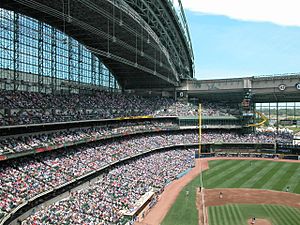
The Milwaukee Brewers, the state's only major league baseball team, play in American Family Field in Milwaukee, the successor to Milwaukee County Stadium since 2001. In 1982, the Brewers won the American League Championship, marking their most successful season. The team switched from the American League to the National League starting with the 1998 season. Before the Brewers, Milwaukee had two prior Major League teams. The first team, also called the Brewers, played only one season in the newly founded American League in 1901 before moving to St. Louis and becoming the Browns, who are now the Baltimore Orioles. Milwaukee was also the home of the Braves franchise when they moved from Boston from 1953 to 1965, winning the World Series in 1957 and the National League pennant in 1958, before they moved to Atlanta.
The Milwaukee Bucks of the National Basketball Association play home games at the Fiserv Forum. The Bucks won the NBA Championship in 1971 and 2021.
The state also has minor league teams in hockey (Milwaukee Admirals) and baseball (the Wisconsin Timber Rattlers, based in Appleton and the Beloit Sky Carp of the High-A minor leagues). In addition to these affiliated minor league teams, Wisconsin has two American Association of Professional Baseball teams, one being the 2020 Championship team Milwaukee Milkmen, based in Franklin, and starting in 2022, the Lake Country DockHounds, based in Oconomowoc. Wisconsin is also home to nine Northwoods League teams. The Madison Mallards, the La Crosse Loggers, the Lakeshore Chinooks, the Eau Claire Express, the Fond du Lac Dock Spiders, the Green Bay Rockers, the Kenosha Kingfish, the Wausau Woodchucks, and the Wisconsin Rapids Rafters, all play in a collegiate all-star summer league. In addition to the Packers, Green Bay is also the home to an indoor football team, the Green Bay Blizzard of the IFL. The state is home to the seven-time MISL/MASL Champion Milwaukee Wave.
Wisconsin is also home to Forward Madison FC, which is a professional soccer team that plays in the USL League One.
Wisconsin also has many college sports programs, including the Wisconsin Badgers, of the University of Wisconsin–Madison and the Panthers of the University of Wisconsin–Milwaukee. The Wisconsin Badgers football former head coach Barry Alvarez led the Badgers to three Rose Bowl championships, including back-to-back victories in 1999 and 2000. The Badger men's basketball team won the national title in 1941 and made trips to college basketball's Final Four in 2000, 2014, and 2015. The Badgers claimed a historic dual championship in 2006 when both the women's and men's hockey teams won national titles.
The Marquette Golden Eagles of the Big East Conference, the state's other major collegiate program, is known for its men's basketball team, which, under the direction of Al McGuire, won the NCAA National Championship in 1977. The team returned to the Final Four in 2003.
Many other schools in the University of Wisconsin system compete in the Wisconsin Intercollegiate Athletic Conference at the Division III level. The conference is one of the most successful in the nation, claiming 107 NCAA national championships in 15 different sports as of March 30, 2015.
The Semi-Professional Northern Elite Football League consists of many teams from Wisconsin. The league is made up of former professional, collegiate, and high school players. Teams from Wisconsin include: The Green Bay Gladiators from Green Bay, The Fox Valley Force in Appleton, The Kimberly Storm in Kimberly, The Central Wisconsin Spartans in Wausau, The Eau Claire Crush and the Chippewa Valley Predators from Eau Claire, and the Lake Superior Rage from Superior. The league also has teams in Michigan and Minnesota. Teams play from May until August.
Wisconsin is home to the world's oldest operational racetrack. The Milwaukee Mile, located in Wisconsin State Fair Park in West Allis, Wisconsin, held races there that considerably predate the Indy 500.
Wisconsin is home to the nation's oldest operating velodrome in Kenosha where races have been held every year since 1927.
Sheboygan is home to Whistling Straits golf club which has hosted PGA Championships in 2004, 2010 and 2015 and the Ryder Cup golf competition between USA and Europe in 2020. The Greater Milwaukee Open, later named the U.S. Bank Championship in Milwaukee, was a PGA Tour tournament from 1968 to 2009 held annually in Brown Deer. In 2017, Erin Hills, a golf course in Erin, Wisconsin, approximately 30 miles northwest of Milwaukee, hosted the U.S. Open.
See also
 In Spanish: Wisconsin para niños
In Spanish: Wisconsin para niños





